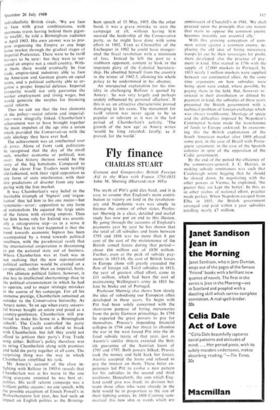Fly finance
CHARLES STUART
Guineas and Gunpowder: British Foreign Aid in the Wars with France 1793-1815 John M. Sherwig (Harvard/our 105s)
The myth of Pitt's gold dies hard, and it is easy to assume that England's main contri-
bution to victory on land in the revolution- ary and Napoleonic wars was simply to finance the armies of other states. Profes- sor Sherwig in a clear, detailed and useful study has now put an end to this illusion. By going through the accounts of England's payments year by year he has shown that the total of all subsidies and loans between 1793 and 1816 was no more than 8 per cent of the cost of the maintenance of the British armed forces during that period— about £66 million out of £830 million. Further, even at the peak of subsidy pay- ments in 1813-14, the cost of British forces in Europe alone still greatly exceeded the flow of foreign aid. Total subsidies in 1813, the year of greatest allied effort, came to £1 1 million, which had been the cost of maintaining Wellington's army in 1811 be- fore he broke out of Portugal.
Professor Sherwig also shows how slowly the idea of subsidising our European allies developed in these years. To begin with Pitt had been solely concerned with the short-term purpose of hiring mercenaries from the petty German princelings. In 1793 he expected the great powers to pay for themselves. Prussia's impending financial collapse in 1794 and her threat to abandon the war in the west forced Pitt into the ill- fated subsidy treaty of that year, just as Austria's similar threats extorted the Brit- ish guarantee of the Austrian loans of 1795 and 1797. Both powers bilked; Prussia took the money and held back her forces; Austria accepted the loans and refused to pay the interest on them. These bitter ex- periences led Pitt to evolve a new pattern for his subsidies in the second and third coalitions. Henceforth, the sum which Eng- land could give was fixed; its division bet- lween those allies who were already in the kid would be in proportion to the size of their• fightihg armies. In 1808 Canning sum- marised this new idea in words which are reminiscent of Churchill's in 1941. 'We shall proceed upon the principle that any nation that starts to oppose the common enemy becomes instantly our essential ally.'
With this growing conception of com- mon action against a common enemy, re- placing the old idea of hiring mercenary troops let out by their sovereigns for profit. there developed also the practice of pay- ment in kind. This started in 1796 with the supply of 12.000 muskets to Portugal; by 1813 nearly 1 million muskets were supplied between our continental allies. At the same time arguments on how subsidies were being spent were ended, where possible, by paying them in the field. But, however re- stricted in their distribution or diluted by payment in kind, the subsidies of these years presented the British government with a technical problem of foreign exchange which was always troublesome. Shortage of specie and the difficulties imposed by Napoleon's Continental System made the transference of funds to Europe awkward. In overcom- ing this the British exploitation of the South American market after I 808 played some part, in the case of Brazil with Portu- guese agreement, in the case of the Spanish colonies in spite of the opposition of the Cadiz government.
By the end of the period the efficiency of the commissary-general, J. C. Herries, in
making subsidy remittances was such that
Castlereagh wrote begging that he should be slowed down. In negotiating with the other powers at Vienna, he explained, 'the poorer they arc kept the better. In this, as in other realms of national effort, practice made perfect. When Napoleon escaped from Elba in 1815, the British government arranged and paid within a year subsidies totalling nearly £7 million.


































 Previous page
Previous page